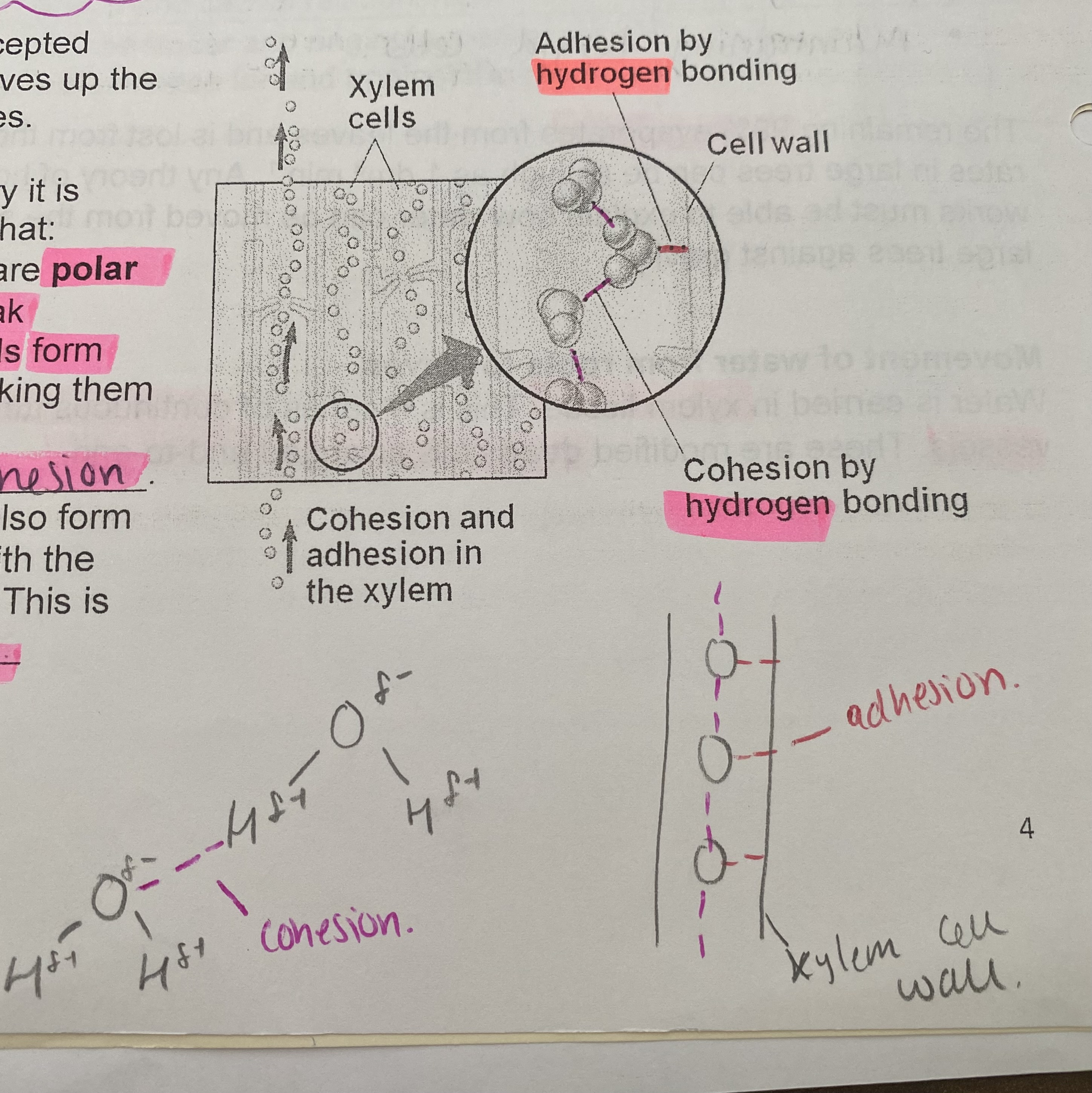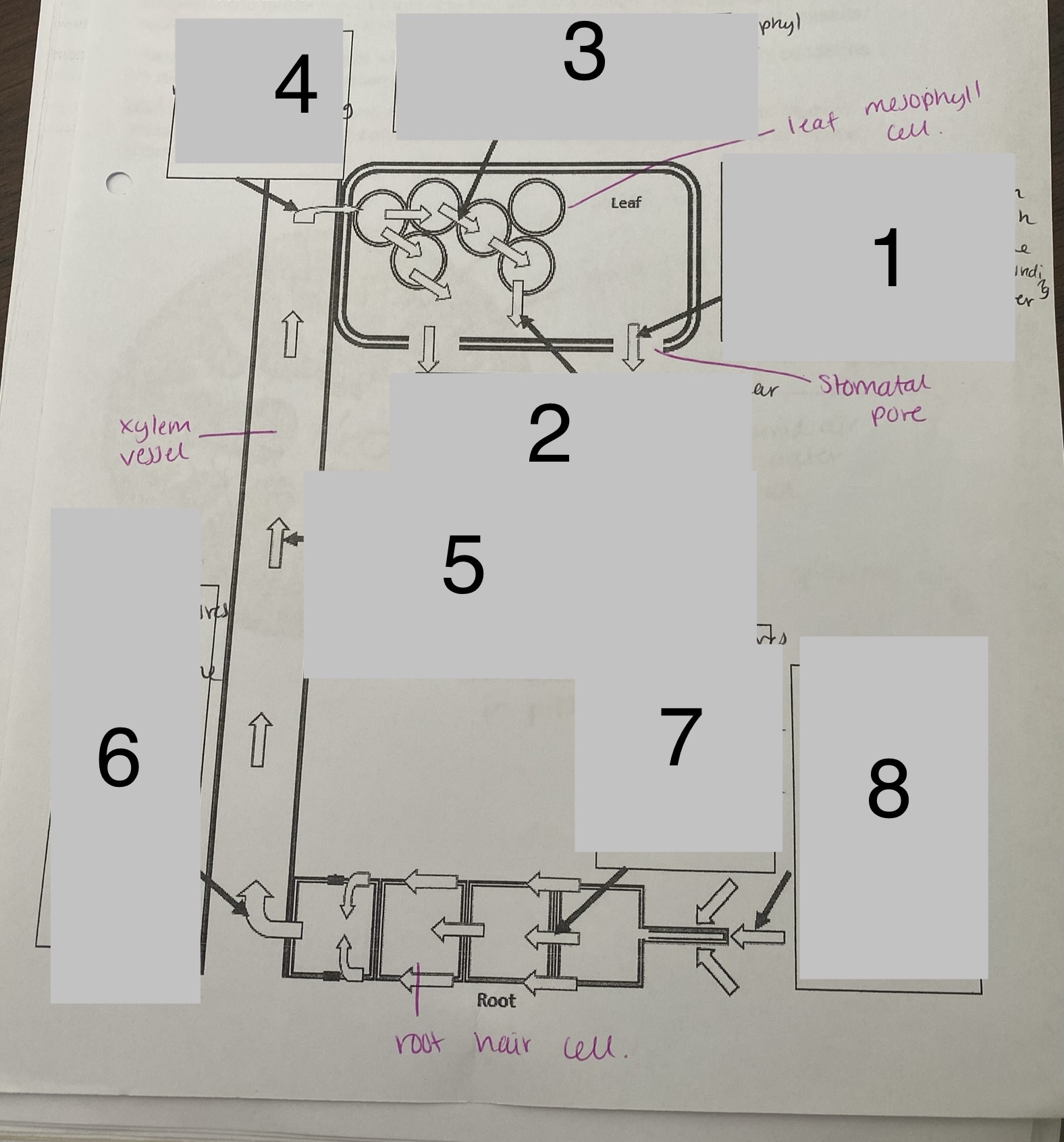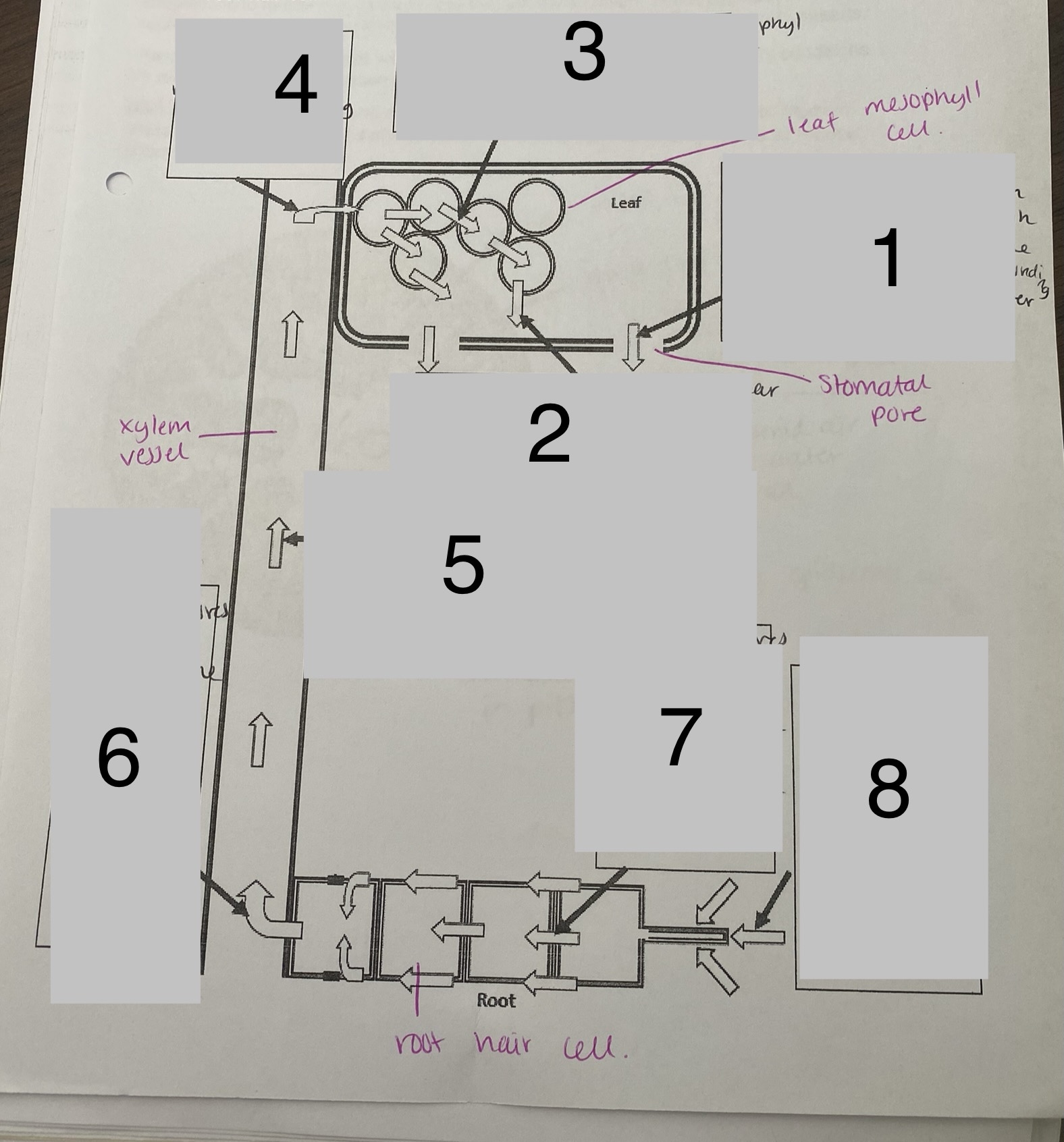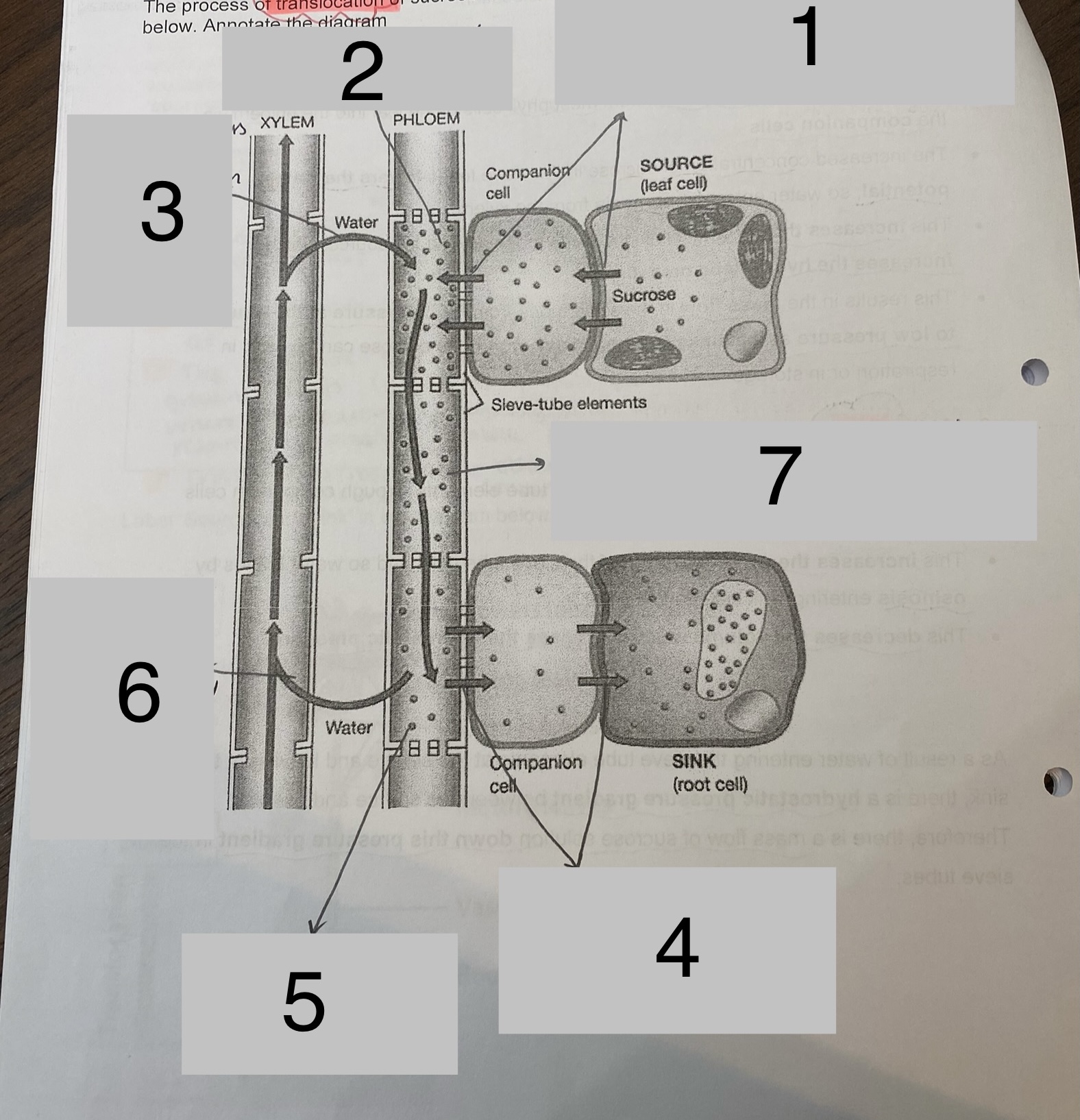7- Transport in Plants
1/49
There's no tags or description
Looks like no tags are added yet.
Name | Mastery | Learn | Test | Matching | Spaced |
|---|
No study sessions yet.
50 Terms
What is mass transport?
the movement of materials over large distances, due to pressure differences
What is transpiration?
the movement of water and dissolved minerals through xylem tissues
What is translocation?
movement of sugars and other soluble organic substances through phloem tissues
What happens during transpiration?
water moves up from the roots and is evaporates out the leaves when stomata are open
What % of water do plants use from the roots?
only about 1%
What % of water evaporates?
99%
What do plants use water for?
photosynthesis
maintaining turgid cells
What are xylem tissues?
continuous tubes that are modified dead cells arranged end-to-end
What are the features of xylem vessels?
cell walls containing lignin
lignified vessel walls cause the cell contents to die
tiny holes called pit in walls of xylem tissues
lose their end walls
What is the function of cell walls containing lignin in xylem vessels?
strengthens xylem walls against tension
make them waterproof
What is the function of lignified walls causing contents to die in xylem vessels?
leaves hollow lumen with little cytoplasm= little resistance
What is the function of tiny holes called pits in xylem vessels?
if vessel become blocked/ damaged, water can divert laterally so upward movement can continue
What is the function of loss of end walls in xylem vessels?
form a continuous column
Suggest an advantage of xylem vessels being dead cells in order to carry out their function effectively
living cells have cell membranes and cytoplasm= water movement would be slower if it had to pass through these
Describe cohesion + adhesion between water molecules
water molecules are polar so very many weak hydrogen bonds form making them stick together= cohesion
water molecules from hydrogen bonds with walls of xylem= adhesion

What factors affect rate of transpiration?
temperature
light intensity
humidity
wind
What is the process of transpiration?
Water is evaporated from mesophyll cells of the leaf, reducing water potential of leaves. Water vapour in the forms in air spaces which diffuses out through open stomata
Water potential gradient is formed. Water leaves xylem in the leaf and diffuse into mesophyll cells by osmosis replacing lost water
Creates negative pressure/ tension at top of xylem vessels
Remaining water in xylem is under tension and pulled up towards leaves
Continuous columns of water maintained due to cohesion between water molecules
Adhesion between xylem vessel walls and water molecules creates an inward pull causing vessels to decrease in diameter
Entirely passive process as no ATP required
Why is rate of transpiration in xylem higher around midday?
increased transpiration rate/ evaporation rate due to increase in temp
increased kinetic energy of water molecules
OR
more stomata open so increase in flow rate due to cohesion/ attraction of water molecules as higher light intensity
What happens when a xylem vessel is broken?
water doesn’t leak out and air is pulled in
How does air being pulled in and water not leaking out support the cohesion-tension theory?
as air is drawn into xylem when it is broken means that water in the xylem must be under tension (pulled from top) rather than under pressure (pushed from bottom) as predicted by the cohesion-tension theory

What is happening at stages 1-4 in the cohesion-tension diagram?
Water diffuses from intercellular spaces in leaf where there is a high water potential, through the stomatal pore, to the surrounding air where there is a lower water potential
The water in the intercellular spaces is replaced by water evaporating from the mesophyll cells
The water lost from the mesophyll cells is replaced by water from neighbouring cells. The water moves from cell to cell by osmosis
Water leaves the xylem and moves into the cells neighbouring the mesophyll cells

What is happening at stages 5-8 in the cohesion-tension diagram?
As transpiration causes a tension in the xylem vessels, water is pulled up in continuous columns due to cohesion between H2O molecules and adhesion between the H2O molecules and the walls of the xylem vessels
Water moves from the root cells into the xylem
Water moves through the cells of the root from root hair cell to the xylem vessels
Water moves into the root hair cells by osmosis
Why is the trunk of a tree’s diameter lowest at noon?
stomata are open
transpiration rates are highest
increased tension so water column pulled up xylem faster= walls of xylem pulled in by adhesion and xylem vessels decrease in diameter
What can be used to measure rates of transpiration?
potometer
Why is the shoot of a plant cut and put into a potometer under water?
to prevent air entering
What are xerophytes?
plants found in any region where water is scarce
What are some plant adaptations to reduce water loss?
waxy water proof covering (cuticle)
close stomata
trap humid air with high water potential
hairs on lower epidermis
stomata sunken in pits
How does trapping humid air with high water potential help limit water loss?
water vapour trapped within the rolled leaf= reduces water potential gradient= lower rate of diffusion from stomata occurs
How do hairs on the lower epidermis help limit water loss?
water vapour trapped between hairs= reduces water potential gradient= lower rate of diffusion and less transpiration
How does stomata sunken in pits help limit water loss?
water vapour held above stomatal pore= reduces water potential gradient= lower rate of diffusion and less transpiration
How does a thick waxy cuticle help limit water loss?
cuticle is waxy= reduces water loss
greater thickness= increases diffusion pathway
= reduces rate of diffusion
What are some other adaptations of xerophytes?
reduction in SA:vol ratio of leaves
stomata confined to underside of leaf
daylight closure of stomata
succulent stems/ leaves
How does a reduction in SA:vol of leaves help limit water loss?
smaller SA:vol ratio= slower rate of diffusion
How does stomata confined to underside of leaves help limit water loss?
underside is cooler= less heat energy to evaporate water
How does daylight closure of stomata help limit water loss?
reduces transpiration during hottest part of day
How do succulent stems/ leaves help limit water loss?
storage of water
Give a reason why plants growing on sand dunes need to have xerophytic features even though there is plentiful rain
rain rapidly drains through the sand out of the reach of roots= sand dunes are in windy situation= reduces water potential of air= increases water potential gradient leading to increased water loss from soil (wind dries sand out)
Why is it necessary to transport sucrose from 1 part of a plant to another?
only leaves photosynthesise to produce sugars but all parts of the plant requires sugars for respiration
Why might non-reducing sugars such as sucrose be transported in the phloem rather than reducing sugars such as glucose?
reducing sugars are too reactive and would be chemically altered before arriving at their destination
What is the structure of the phloem tissue?
sieve tube elements link to the next which are perforated with pores
little to no cytoplasm and organelles but little mitochondria
alive cells
What are sources?
where organic solutes are produced and are therefore at a high concentration
source for sucrose is usually the mesophyll cells of the leaves where it is formed by the condensation of fructose and glucose
What are sinks?
where organic solutes are used up and are therefore at a low concentration
sinks are the other parts of the plant, especially the growing points (meristem) of roots, stems, flowers and leaves where sucrose is hydrolyses to glucose and fructose and then respired to provide metabolic energy in the form of ATP
fruits, seeds, roots and other storage organs act as sinks when sucrose is converted into starch and stored
Explain the mass flow theory at the source
Sucrose is actively transported from mesophyll cells of leaf into phloem by companion cells
The increased concentration of sucrose in the sieve tubes lower water potential so water enter by osmosis from the xylem
This increases volume within sieve tubes around the source, which increases hydrostatic pressure
This results in mass flow from high pressure at sources to low pressure at roots where sucrose can be used in respiration or storage
Explain the mass flow theory at the sink
Sucrose is actively transported from sieve tubes through companion cells to sinks
This increases water potential of sieve tube cells so water leaves by osmosis entering sink cells (and xylem)
This decreases volume which decreases hydrostatic pressure
There is a hydrostatic pressure gradient formed so there is a mass flow of sucrose solution down this pressure gradient in the sieve tubes

What is happening at stage 1-7 during translocation?
Active transport of sucrose from source/ leaves to phloem
High sucrose conc/ low water potential gradient in phloem
Water enters by osmosis creating high hydrostatic pressure at source
Active transport of sucrose from phloem to sink
Low sucrose conc/ high water potential gradient
Water leaves phloem by osmosis creating low hydrostatic pressure at sink
Mass flow of sucrose solution down a hydrostatic gradient in the sieve tubes
Compare phloem to xylem
XYLEM:
transports water and mineral ions
have no cross walls
walls impregnated with lignin
vessels contain pits that allow water to pass into adjacent vessels
dead cells
PHLOEM:
transports organic solutes such as sucrose/ amino acids
sieve tubes contain perforated cross wall called sieve plates
have no additional support
many gaps in cell walls between companion cells and sieve tube elements called plasmodesmata
living cells
What is some evidence supporting mass flow theory?
high hydrostatic pressure in phloem shown when they are cut, they release sap
concentration of sucrose is higher in leaves than root (sinks)
downward flow in phloem in daylight, but ceases at night
increases in sucrose levels in leaves followed by increase in phloem a little later
metabolic inhibitors/ lack of oxygen inhibit translocation
companion cells have many mitochondria
What is some evidence against mass flow theory?
function of sieve plates unclear
not all solutes move at the same speed
sucrose is delivered at the same rate to all sinks
Explain in terms of mass flow theory why downward flow in the phloem ceases at night
no/little photosynthesis so production of sucrose stopped/ reduced
no/little sucrose actively transported into the sieve tubes/ phloem
conc of sucrose not increased/ water potential not decreased in sieve tubes/ phloem
no/little water enters sieve tubes/ companion cells/ phloem from xylem
no/ less hydrostatic pressure gradient produced
How do radioactive tracer experiments work?
Plant exposed to atmosphere containing radioactively labelled carbon dioxide 14^CO2 carbohydrates
Movement of these carbohydrates can be traced by cutting tissue from different areas into thin sections
Then place a photographic film over the specimens
The film blackens where it is exposed to the radioactive isotope (called autoradiography)